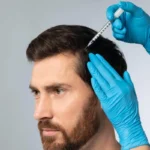Scarring. It’s an inevitable result of the wound-healing process, which involves a complex interplay of biochemical and physiological factors. While scarring is a natural and necessary part of the healing process, it can also be a source of frustration and embarrassment for those who suffer from it. This is because scarring can take many forms, ranging from mild and barely noticeable to severe and disfiguring. Moreover, the factors contributing to scarring are numerous and complex, including genetic and environmental factors that can make predicting and preventing scarring difficult.
Despite these challenges, various treatments can help reduce the appearance of scars and enhance the overall quality of life for those affected by them. In this article, we will explore the topic of scarring in depth, including its causes, types, and treatments.
What Causes Scarring?
The wound healing process is a complex, multi-step process that involves a delicate interplay of various cell types and signaling molecules. When the skin is damaged, a series of events is set in motion, ultimately forming scar tissue. But what exactly triggers this process? During the wound healing process, specialized cells called fibroblasts migrate to the injury site and begin to synthesize a type of collagen known as Type III collagen. This initial collagen provides the scaffold upon which subsequent healing occurs. Over time, the Type III collagen is replaced by stronger Type I collagen, which helps to create scar tissue. However, scarring is not a uniform process, and various factors can influence the extent and type of scarring. Genetic predisposition, environmental factors such as exposure to sunlight or pollutants, and individual differences in the immune response and wound healing process can all play a role in determining the scarring outcome. Furthermore, age, nutrition, and stress levels can all impact the wound-healing process and ultimately contribute to scarring.
Types Of Scarring
When it comes to scarring, there’s no one-size-fits-all solution. Each type of scar presents unique challenges and treatment options, from hypertrophic to keloid scars, from hypertrophic to contracture scars.
- Hypertrophic scars are raised, red, and often itchy or painful, typically forming within the boundaries of the original wound.
- Keloid scars, on the other hand, extend beyond the original wound and can become large, thick, and disfiguring.
- Atrophic scars, by contrast, are sunken or depressed and can result from conditions such as acne or chickenpox.
- Finally, contracture scars are tight and shiny and can restrict movement, often occurring in burn patients.
Treatments For Scarring
When treating scarring, various options are available, ranging from topical treatments to invasive surgical procedures. However, for those seeking a non-invasive approach, several promising therapies have shown effectiveness in reducing the appearance of scars. Here are some of the non-invasive procedures that can help address scarring:
- Silicone gel or sheeting: These can help to soften and flatten scars by moisturizing the skin and providing a protective barrier.
- Cryotherapy: This involves freezing the scar tissue with liquid nitrogen to stimulate the growth of new, healthy tissue.
- Laser therapy: Different types of lasers can target specific types of scarring, such as pulsed-dye lasers for red or pink scars or fractional lasers for deep, pitted scars.
- Microneedling: This procedure involves using tiny needles to create micro-injuries in the skin, stimulating collagen production and improving the texture and appearance of scars.
- Chemical peels: These can help to exfoliate the top layer of skin and reduce the appearance of superficial scars, such as those caused by acne.
- Dermabrasion: This procedure involves using a rotating brush or diamond wheel to remove the top layer of skin, allowing new, healthier skin to grow in its place.
- Microdermabrasion: Similar to dermabrasion, but uses a less invasive method to exfoliate the top layer of skin.
- Ultrasound therapy: This treatment uses high-frequency sound waves to stimulate the production of collagen and elastin, which can improve the texture and appearance of scars.
- Radiofrequency therapy: This procedure uses radio waves to heat the skin, stimulating collagen production and improving the appearance of scars.
- Platelet-rich plasma (Natural Growth Factor Injections) therapy: This treatment involves injecting platelet-rich plasma derived from the patient’s blood into the scar tissue to stimulate healing and collagen production.
- Injection therapy involves injecting substances such as corticosteroids or fillers into the scar tissue to reduce inflammation and improve the appearance of scars.
Work With A Professional
When it comes to treating scarring, the sheer number of options available can be overwhelming. With so many treatments and procedures, it can take time to determine which one best suits your particular concerns. That’s where working with a professional comes in.
By consulting with a qualified dermatologist or plastic surgeon, you can receive expert guidance and recommendations on the most effective treatments for your specific type of scarring. A professional can help you navigate the many options available and create a customized treatment plan that considers your individual needs and concerns.
Additionally, working with a professional can help ensure that you receive safe and effective treatment. While many non-invasive procedures are relatively low-risk, there are still potential side effects and complications. A professional can help you understand the risks and benefits of each treatment option and make an informed decision about which one to pursue.
Takeaway
If you’re struggling with scarring and looking for a professional to guide you through finding the proper treatment, look no further than Refine Medical Center. Our team of experienced dermatologists and plastic surgeons can help you navigate the various treatment options available and create a personalized plan that addresses your specific concerns. At Refine Medical Center, we specialize in non-invasive procedures that can effectively address scarring without the need for surgery or lengthy recovery times. From laser therapy to micro needling and beyond, we offer a range of cutting-edge treatments that can help you achieve smoother, more even skin.
So why wait? If you’re ready to take the first step towards achieving the complexion of your dreams, contact Refine Medical Center today to schedule a consultation with one of our experts. We’ll work with you to develop a customized treatment plan that helps you achieve your desired results safely and effectively.





